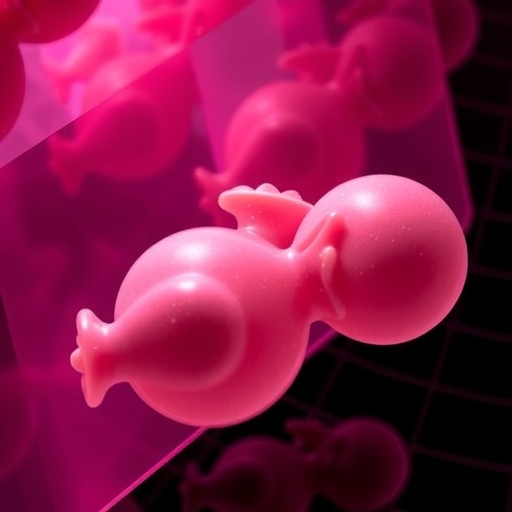
Credit: Beth Israel Deaconess Medical Center
BOSTON – Abundant in human babies and small mammals, brown adipose tissue (BAT), or brown fat, was only recently discovered in human adults, and its role remains unclear. Known to play an integral part in generating body heat and burning stored energy, its presence is linked to lower body weight and improved blood sugar levels, making it an attractive research target for potential treatments for diabetes, obesity and other metabolic diseases.
Now, endocrinologists at Beth Israel Deaconess Medical Center (BIDMC) have shown for the first time that brown fat can exert control over skeletal muscle function. Alterations to the brown adipose tissue in mice resulted in a significant and consistent reduction in exercise performance. The findings, published today in the journal Cell Metabolism, shed new light on the biology of the enigmatic brown adipose tissue as well as open the door to potential new therapies for certain metabolic and muscular diseases.
Evan Rosen, MD, PhD, Chief of the Division of Endocrinology, Diabetes and Metabolism at BIDMC, studies specific proteins that regulate genes, called transcription factors, focusing on those that are critical for adipose function and metabolism. Much of his recent work has centered on a factor called IRF4, which is usually thought of as a protein that regulates the immune system. A decade ago, Rosen and his team discovered that IRF4 is vital for adipose tissue function, and in 2014 they further identified IRF4 as a key regulator of energy burning and heat production (collectively known as thermogenesis) in brown fat.
"We knew that muscles could regulate brown fat – exercising increases brown fat – but it was unknown whether brown fat affected muscle function," says Rosen. "In this new study, we closed the loop and demonstrated that the loss of IRF4 in brown fat tissue reduces exercise capacity in rodents, affecting cellular function and causing physiological abnormalities in the muscle tissue itself."
Rosen – with colleagues including Xingxing Kong, PhD, formerly a post-doctoral fellow in Rosen's lab and now a faculty member at the David Geffen School of Medicine at the University of California, Los Angeles – compared the exercise capacity of mice designed to lack IRF4 in their brown adipose tissue with that of normal – or "wild-type" – mice. While the altered mice looked and acted normal, they consistently demonstrated diminished exercise capacity compared to the wild-type animals.
Mice with brown fat lacking IRF4 performed about 14 percent worse on a slow-speed treadmill and about 38 percent worse at higher speeds. When Rosen and colleagues compared the rodents' muscles, they saw distinct abnormalities in the thigh muscles of mice with altered brown fat. In some of the muscle cells, the structures that allow muscles to contract, the sarcoplasmic reticulum, were abnormally large, coiled up like a garden hose inside each muscle cell – a characteristic reminiscent of a rare muscle disease in humans called tubular aggregate myopathy.
"It left the muscle cells unable to process energy well, but the key finding here is that by altering brown fat tissue, we altered the muscle inadvertently," said Rosen.
To tease out the molecular pathway by which IRF4 exerts this control over muscle, the team of scientists looked at the genes expressed, not in the muscle tissue, but in the altered brown fat. They found that a hormone called myostatin – well-known to suppress muscle function and normally silenced in brown adipose tissue – was switched on in the absence of IRF4.
The team also showed that placing normal mice at warm temperatures, which naturally shuts off IRF4, had the same effect as knocking out the gene; these mice also showed a reduced ability to exercise. This was associated with higher myostatin levels, and surgically removing the BAT (and thus lowering the myostatin levels) in these warm mice restored their ability to exercise normally.
In addition to furthering researchers' basic understanding of brown adipose tissue, the findings may also open the door to new therapies for people with certain muscle diseases. What's more, many athletes suspect training in the cold can improve performance. Rosen suggests his team's findings support this idea.
###
In addition to Rosen, co-authors include Peng Zhou, Danielle Tenen, Anna Lyubetskaya, Brian Dawes, Linus Tsai, and Barbara Kahn of BIDMC; Lawrence Kazak and Bruce Speigelman of Dana-Farber Cancer Institute; co-corresponding author Tiemin Liu of Fudan University, Shanghai, China; and lead authors Xingxing Kong and Ting Yao of David Geffen School of Medicine at the University of California, Los Angeles.
This work was funded by R00 DK106550, the Major Research Plan of the National Natural Science Foundation of China (91749104), Shanghai Pujiang Talent Project (18PJ1400700), Science and Technology Innovation Action Plan of Shanghai Science and Technology Committee (18140901300), Open Research Fund of State Key Laboratory of Pharmaceutical Biotechnology (KF-GN-201701), and grants from the National Institutes of Health (NIH R01 DK31405, NIH R37 DK43051, NIH R01 DK085171, DK102173, DK113669 and DK102170).
About Beth Israel Deaconess Medical Center
Beth Israel Deaconess Medical Center is a patient care, teaching and research affiliate of Harvard Medical School and consistently ranks as a national leader among independent hospitals in National Institutes of Health funding.
BIDMC is in the community with Beth Israel Deaconess Hospital-Milton, Beth Israel Deaconess Hospital-Needham, Beth Israel Deaconess Hospital-Plymouth, Anna Jaques Hospital, Cambridge Health Alliance, Lawrence General Hospital, MetroWest Medical Center, Signature Healthcare, Beth Israel Deaconess HealthCare, Community Care Alliance and Atrius Health. BIDMC is also clinically affiliated with the Joslin Diabetes Center and Hebrew Rehabilitation Center and is a research partner of Dana-Farber/Harvard Cancer Center and the Jackson Laboratory. BIDMC is the official hospital of the Boston Red Sox. For more information, visit http://www.bidmc.org.
Media Contact
Jacqueline Mitchell
[email protected]
617-667-7306
@BIDMCNews
http://www.bidmc.harvard.edu
Original Source
https://www.bidmc.org/about-bidmc/news/2018/08/new-light-shed-on-relationship-between-calorie-burning-fat-and-muscle-function





